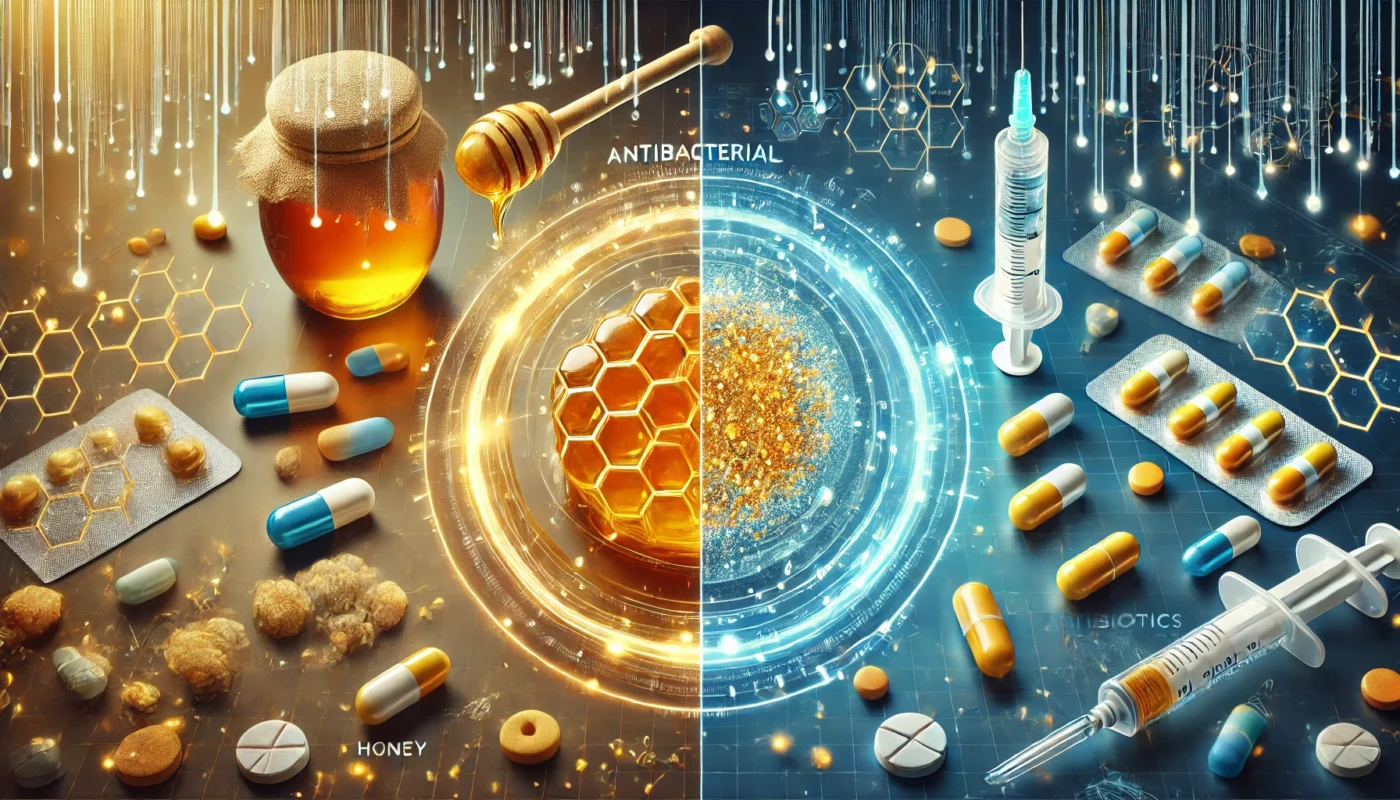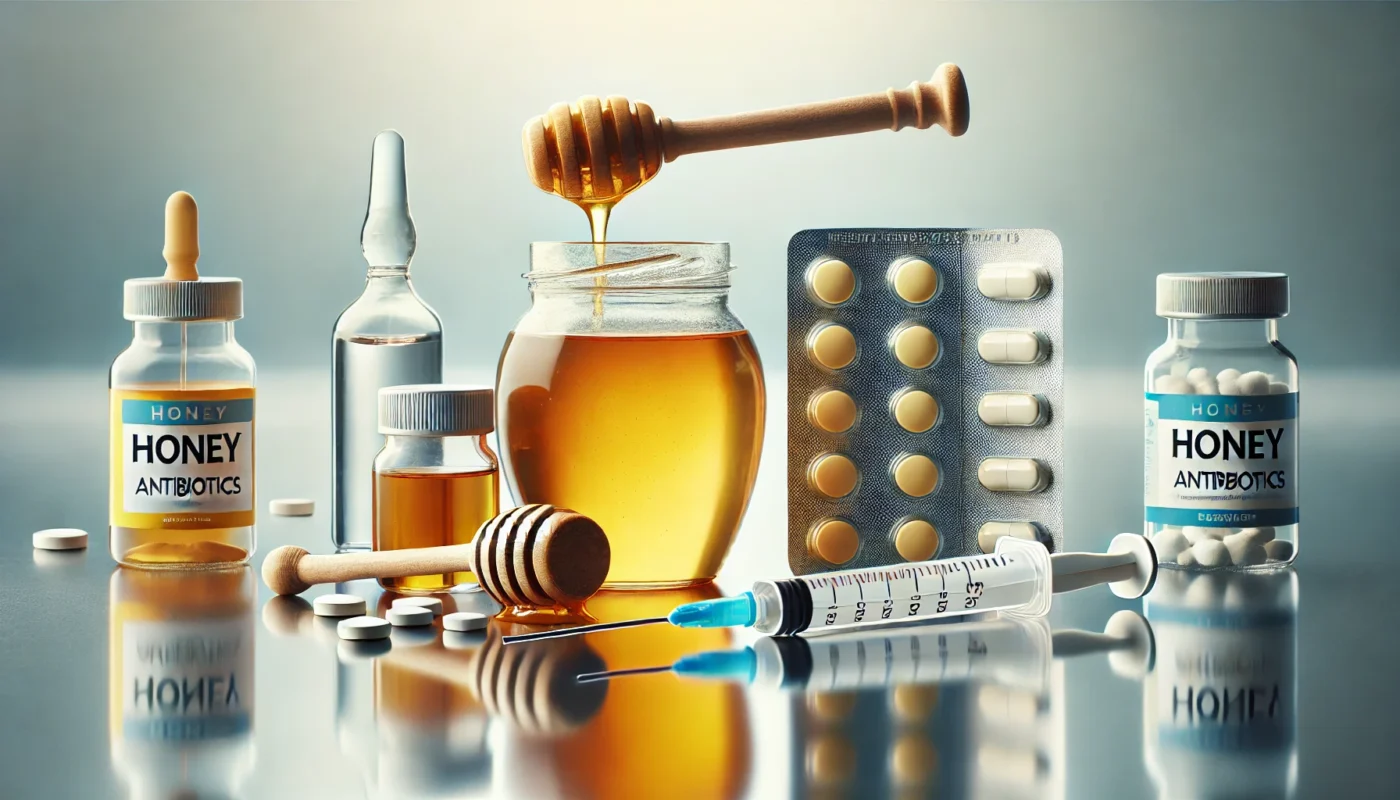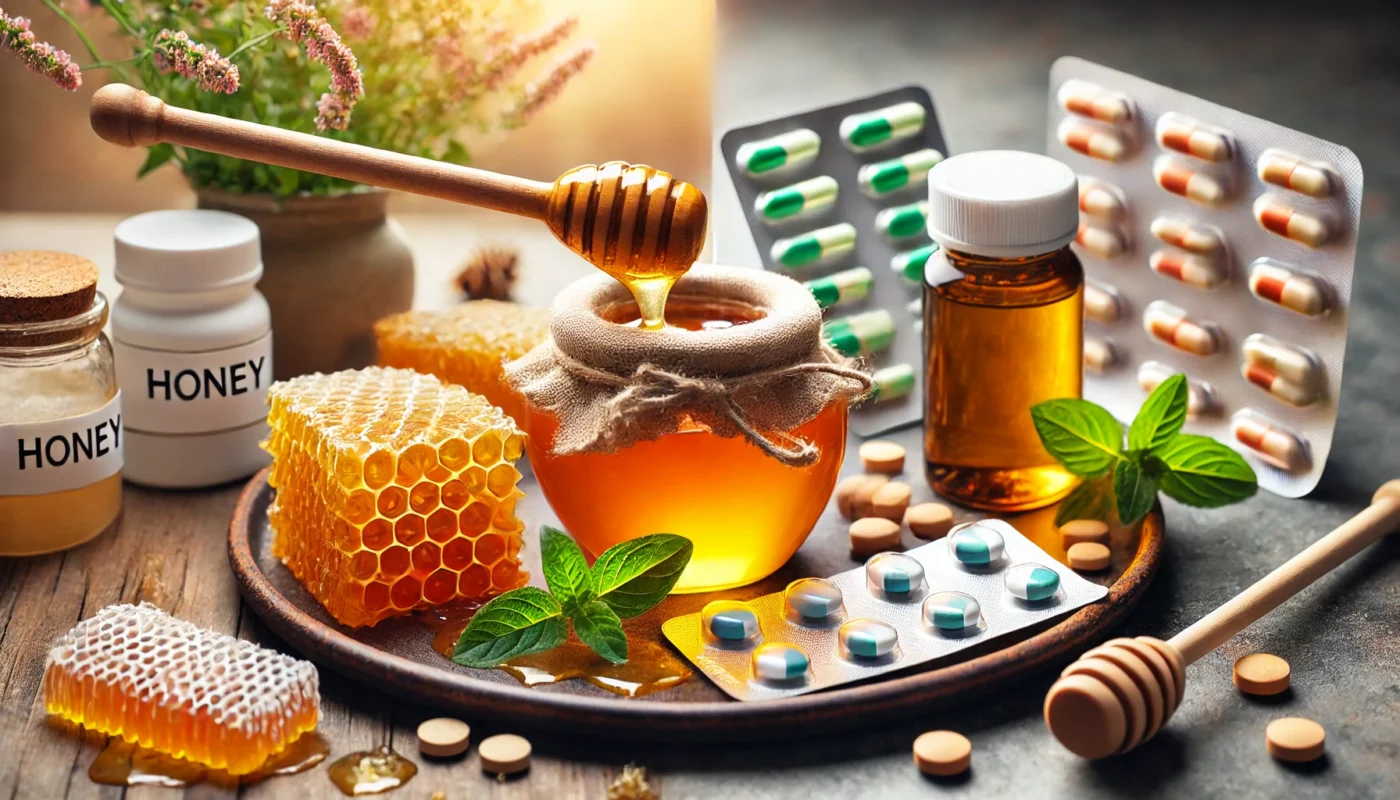Honey is not just a sweet treat; it has been revered for its healing properties for thousands of years. This section explores the historical and scientific foundations of honey’s medicinal uses.
You may also like: Home Remedies: Fight Cut Infections Naturally
A Historical Perspective
Honey has been used for its medicinal properties for centuries. Ancient civilizations, including the Egyptians, Greeks, and Romans, recognized honey not only as a food source but also as a healing agent. It was applied to wounds and used to treat a variety of ailments due to its antibacterial and anti-inflammatory properties.
Throughout history, honey has been a staple in traditional medicine across cultures. The Egyptians used it in embalming practices, while the Greeks and Romans valued it for its ability to heal wounds. In traditional Chinese medicine, honey is considered a harmonizing agent, believed to balance the body’s energies.
In ancient texts, honey was often described as a gift from the gods, highlighting its revered status. Its use extended beyond medicine, playing a role in religious rituals and offerings. This historical reverence underscores the enduring belief in honey’s healing power.
The Science Behind Honey as an Antibiotic
Recent scientific studies have confirmed what our ancestors intuitively knew—honey possesses potent antibacterial properties. This is primarily due to the presence of hydrogen peroxide, low pH levels, and high osmolarity, all of which create an environment hostile to bacteria.
Moreover, specific types of honey, such as Manuka honey, contain a unique compound called methylglyoxal (MGO), which is responsible for its exceptional antibacterial effects. This makes Manuka honey a popular choice for medicinal use.
Scientific research has identified several components in honey that contribute to its antibacterial properties. Enzymes in honey produce hydrogen peroxide, a known disinfectant, while its acidic nature inhibits bacterial growth. High sugar concentration also contributes by drawing moisture away from bacterial cells, effectively dehydrating and killing them.
Manuka honey, in particular, has been studied extensively for its potent antibacterial properties. Its high MGO content is unique among honey varieties, making it particularly effective against a wide range of bacteria, including some antibiotic-resistant strains. This has led to its widespread use in medical settings, particularly in wound care.
The Anti-Inflammatory and Antioxidant Effects
Beyond its antibacterial qualities, honey is also known for its anti-inflammatory and antioxidant effects. These properties make it useful in treating various inflammatory conditions and in promoting overall health.
The anti-inflammatory properties of honey help in reducing swelling and pain associated with wounds and burns. This makes honey not only a healing agent but also an analgesic that can enhance comfort during the healing process. Its application can reduce the need for additional pain management in minor injuries.
Antioxidants in honey, such as flavonoids and phenolic acids, play a crucial role in neutralizing free radicals in the body. This activity contributes to reducing oxidative stress, which is linked to chronic diseases such as cancer and cardiovascular conditions. Regular consumption of honey can support the body’s defense against these diseases by enhancing its antioxidant capacity.

How to Use Honey as an Antibiotic
Incorporating honey into your health regimen requires understanding its different uses and applications. This section provides practical guidance on how to effectively use honey as a natural antibiotic.
Topical Application
One of the most common ways to use honey as an antibiotic is through topical application. For minor cuts, abrasions, or burns, applying a thin layer of honey can aid in wound healing and prevent infection. To ensure maximum effectiveness, it’s recommended to use medical-grade honey, such as Manuka honey, which is specifically processed for therapeutic use.
To apply honey topically, first clean the wound with mild soap and water to remove any debris or contaminants. Pat the area dry with a clean towel. Apply a thin layer of honey directly onto the wound, covering it entirely. For added protection, cover the honey-applied area with a sterile bandage or dressing.
Changing the dressing regularly, at least once a day or whenever it becomes wet or dirty, is crucial for optimal healing. This ensures that the antibacterial environment is maintained, preventing infection and promoting faster recovery. Always observe the wound for signs of infection, such as increased redness, swelling, or pus, and consult a healthcare professional if these occur.
Internal Use
In addition to its topical benefits, honey can also be consumed to fight internal infections. A simple remedy involves mixing honey with warm water and lemon to soothe a sore throat or alleviate the symptoms of a cold. The natural compounds in honey can help reduce inflammation and support the immune system.
Consuming honey regularly can also provide a gentle boost to the immune system, helping to prevent illnesses before they start. Its natural enzymes and antioxidants work together to promote overall health and resilience against infections.
For digestive health, honey can be taken as a prebiotic, supporting the growth of beneficial gut bacteria. This not only aids digestion but also enhances the body’s ability to fight off pathogens, contributing to a stronger immune response.
Precautions and Considerations
While honey is generally safe for most people, it is crucial to remember that it should not be given to infants under one year old due to the risk of botulism. Additionally, individuals with allergies to pollen or bee products should exercise caution when using honey.
For those with diabetes, it’s important to monitor blood sugar levels when consuming honey, as it can impact glucose levels. Moderation is key, and consulting with a healthcare provider can provide personalized guidance on how to incorporate honey safely into the diet.
It’s also essential to choose high-quality honey, preferably raw and organic, to ensure it retains its natural medicinal properties. Processed honey may lose these beneficial compounds, reducing its effectiveness as a natural remedy.
Honey vs. Traditional Antibiotics
Understanding how honey compares to traditional antibiotics can help individuals make informed decisions about their health. This section examines the strengths and limitations of honey as an antibiotic alternative.
Comparing Efficacy
The efficacy of honey as an antibiotic varies depending on the type of infection and the strain of bacteria involved. While honey has proven effective against many common bacteria, it may not be suitable for severe infections that require powerful antibiotics prescribed by a healthcare professional.
In cases of mild infections or as a preventive measure, honey can be an effective alternative, particularly when dealing with skin infections or sore throats. Its natural properties offer a gentle yet potent solution that supports healing without the side effects associated with antibiotics.
However, for serious or systemic infections, such as pneumonia or sepsis, traditional antibiotics remain essential. They provide targeted action against specific pathogens and are necessary for conditions that pose significant health risks if left untreated.
Antibiotic Resistance
One of the significant advantages of using honey as a natural antibiotic is its potential to combat antibiotic-resistant bacteria. As antibiotic resistance becomes an increasing concern, alternative remedies like honey offer a promising solution by reducing the overuse of conventional antibiotics.
Honey’s multifaceted approach to fighting bacteria, through its various antibacterial compounds, reduces the likelihood of bacteria developing resistance. This makes it a valuable tool in the fight against resistant strains, which are becoming more prevalent due to the overprescription of antibiotics.
By incorporating honey into treatment regimens, healthcare providers can potentially slow the progression of antibiotic resistance, preserving the efficacy of existing antibiotics for future generations. This proactive approach is crucial in addressing one of the most pressing public health challenges of our time.
Limitations and Challenges
Despite its benefits, honey is not a panacea for all infections. Its effectiveness is limited to certain types of bacteria and may not work against viruses or fungi. Understanding these limitations is key to using honey appropriately in a medical context.
One challenge is the variability in honey’s potency, which can depend on factors such as the type of flowers visited by bees and the processing methods used. Not all honey is created equal, and ensuring consistent quality and efficacy can be difficult without standardized measures.
Additionally, while honey is generally safe, it is not without potential side effects. Allergic reactions, though rare, can occur, and it’s important for individuals to be aware of their sensitivities before using honey as a treatment.

The Role of Honey in Modern Medicine
Honey’s resurgence in modern medicine highlights its potential as a complementary therapy. This section explores how honey is being integrated into contemporary healthcare practices and its future prospects.
Integrating Honey into Holistic Health Practices
For those interested in holistic health practices, honey can be a valuable addition to a wellness routine. It complements other natural remedies and can be used in conjunction with traditional medical treatments to enhance overall health and wellbeing.
Incorporating honey into a holistic approach involves using it as part of a balanced lifestyle that includes a nutritious diet, regular exercise, and stress management techniques. Honey can be used in various forms, from topical applications to dietary supplements, to support the body’s natural healing processes.
Practitioners of holistic medicine often recommend honey for its ability to harmonize the body’s energies and promote balance. Its versatility allows it to be used alongside herbal remedies, acupuncture, and other integrative therapies, creating a comprehensive approach to health and healing.
Scientific Research and Future Potential
Ongoing research continues to explore the full potential of honey as a medicinal agent. Studies are investigating its role in wound care, gut health, and even its potential to inhibit the growth of cancer cells. As more scientific evidence becomes available, honey may become an even more integral part of modern medicine.
Research into honey’s role in wound care has shown promising results, particularly in the treatment of chronic wounds and ulcers. Its ability to promote tissue regeneration and reduce inflammation makes it a valuable tool in managing these difficult-to-treat conditions.
Emerging studies are also examining honey’s impact on gut health, exploring its prebiotic effects and potential to improve digestive function. This could lead to new applications in managing gastrointestinal disorders and enhancing overall digestive wellness.
The potential anticancer properties of honey are an exciting area of research, with studies investigating its ability to inhibit tumor growth and enhance the effectiveness of conventional cancer treatments. While more research is needed, these findings suggest that honey could play a role in future cancer therapies.
Regulatory and Quality Considerations
As honey gains recognition in the medical field, ensuring its quality and safety becomes paramount. Regulatory standards and quality control measures are necessary to maintain the integrity and efficacy of honey used for medicinal purposes.
Standardizing honey products, particularly Manuka honey, requires establishing clear guidelines for its production, testing, and labeling. This ensures that consumers and healthcare providers can trust the quality and potency of the honey they use.
Regulatory bodies are working towards developing these standards, which will help in verifying the authenticity and therapeutic value of honey products. This will support its integration into mainstream medicine, providing patients with reliable and effective natural treatment options.

Practical Tips for Incorporating Honey into Your Routine
Integrating honey into your daily life can be both simple and beneficial. This section provides practical advice on selecting and using honey effectively to enhance your health.
Selecting the Right Honey
When choosing honey for medicinal purposes, opt for raw, unprocessed varieties. Manuka honey, with its high MGO content, is particularly effective for therapeutic use. Look for products with a UMF (Unique Manuka Factor) rating, which indicates the quality and potency of the honey.
Understanding the different types of honey and their unique properties can help you select the best option for your needs. Raw honey retains its natural enzymes and nutrients, making it more effective than processed varieties.
The UMF rating system helps consumers identify authentic Manuka honey and assess its antibacterial potency. Higher UMF ratings indicate greater therapeutic potential, making it important to choose the appropriate level for your health goals.
Daily Use Recommendations
Incorporate honey into your daily routine by adding it to tea, yogurt, or smoothies. Its natural sweetness can be a healthier alternative to refined sugars and can enhance the flavor of many dishes while providing health benefits.
Using honey as a sugar substitute can help reduce caloric intake and support weight management efforts. Its natural sweetness satisfies cravings without the negative health effects associated with processed sugars.
Beyond sweetening beverages and foods, honey can be used in salad dressings, marinades, and even baking. Its versatility makes it easy to include in a variety of dishes, allowing you to enjoy its health benefits throughout the day.
Monitoring Health and Seeking Medical Advice
While honey can be a beneficial addition to a health regimen, it is essential to monitor your health and consult with a healthcare professional, especially for persistent or serious conditions. Honey should complement, not replace, professional medical treatment when necessary.
Regular health check-ups and open communication with your healthcare provider are important when using honey as part of your wellness routine. This ensures that any underlying health issues are addressed and that honey is used safely and effectively.
If you experience any adverse reactions or if your condition does not improve, seek medical advice promptly. Healthcare professionals can provide guidance on how to integrate honey into your treatment plan and ensure it aligns with your overall health strategy.
Conclusion
Honey, with its rich history and scientifically backed health benefits, presents an intriguing alternative to traditional antibiotics. While it may not replace antibiotics in all scenarios, it serves as a valuable tool in the holistic health toolkit. By understanding how to use honey effectively and safely, individuals can harness its natural properties to support their health and wellbeing.
As always, it is important to remain informed and consult with healthcare providers to ensure that any natural remedy, including honey, is used appropriately and safely for your individual health needs. By doing so, you can enjoy the sweet benefits of honey while maintaining a balanced and informed approach to your health.
Further Reading:
Honey: Another Alternative in the Fight against Antibiotic-Resistant Bacteria?
How to Use Honey as an Antibiotic
Freshness matters: Study finds newer honey packs a stronger antibacterial punch
honey, holistic health, natural remedies, medicinal honey, Manuka honey, wound care, gut health, cancer research, prebiotics, health tips, nutrition, wellness, alternative medicine, dietary supplements, quality control, healthcare advice
Important Note: The information contained in this article is for general informational purposes only, and should not be construed as health or medical advice, nor is it intended to diagnose, prevent, treat, or cure any disease or health condition. Before embarking on any diet, fitness regimen, or program of nutritional supplementation, it is advisable to consult your healthcare professional in order to determine its safety and probable efficacy in terms of your individual state of health.
Regarding Nutritional Supplements Or Other Non-Prescription Health Products: If any nutritional supplements or other non-prescription health products are mentioned in the foregoing article, any claims or statements made about them have not been evaluated by the U.S. Food and Drug Administration, and such nutritional supplements or other health products are not intended to diagnose, treat, cure, or prevent any disease.

